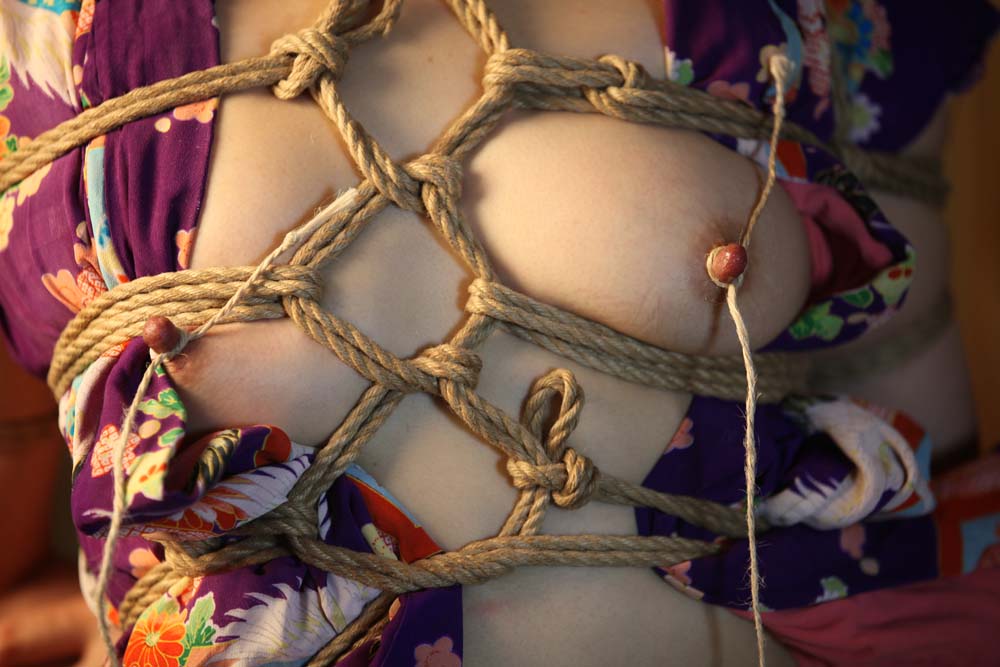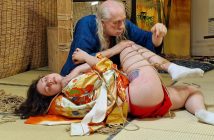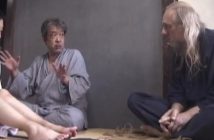‘Muga‘ (無我) is a concept steeped in the Buddhist tradition. It refers to the ‘non-self’, emptiness, or being devoid of desire. As such, it is not the first thing that springs to mind when considering shibari/kinbaku (縛り/緊縛). After all, isn’t the essence of any rope session also an exercise in desire and passion?
Before taking a closer look at muga and how it could be applied to shibari/kinbaku, let’s cast a glance backwards in time. The Chinese character 縄 can be read both as ‘nawa‘ and as ‘jo‘; essentially, the kanji expresses the meaning: ‘rope’. However, depending on context, it could also mean a bondage style or pattern. As an example of all not being quite as simple as perhaps initially thought, take the characters for ‘hojojutsu‘ (捕縄術) – the ancient art of capturing with rope. The same three kanji can also be read as ‘torinawajutsu‘. This ‘art’, in its hoshu hojojutsu (捕手捕縄術) form, has been inextricably linked with the 18 warrior skills of the Samurai (‘bugei juhappan‘, 武芸十八般). As such, it provides for several hundred years of highly advanced rope-tying techniques and represents a solid foundation for modern-day shibari/kinbaku.
Consider also the following examples, where the reading of 縄 is ‘nawa‘: 責め縄 (‘semenawa‘) – bondage geared towards torture; 首斬縄 (‘kubikirinawa‘) – bondage appropriate to beheadings; 火焙縄 (‘hiaburinawa‘) – bondage suitable for burnings at the stake; 早縄 (‘hayanawa‘) – the actual (relatively short) rope employed for initial arrests and swift take-downs; 本縄 (‘honnawa‘) – the actual (relatively long) rope used for more complicated bondage once a person has been arrested.
Returning to the fact that today’s contemporary Japanese tying methods are based around ancient Samurai martial arts (‘kobudo‘, 古武道), by extension it follows that shibari/kinbaku are similarly guided by the same principles governing all other Japanese martial arts. Further, a profound understanding of these would often have meant the difference between life and death. In this way, it is not too far-fetched to imagine that both a solid foundation in tying skills and the observance of a few time-worn principles would be the difference between a so-so bondage session and an out-of-this-world kinbaku session.
Now quickly fast-forward to muga (無我), and what it can bring to your tying experiences. Firstly, let’s contemplate what the legendary grandmaster Akechi Denki (明智伝鬼) explained to me two weeks before his death: “I empty my mind. The ideas then just come to me: from within or from the partner I’m tying. Sometimes the ropes move of their own accord and my hands simply follow, and that is always such an amazing experience. I just disappear. The shibari is always so beautiful whenever that happens.”
That elusive ‘empty mind’ also plays a fundamental role at the higher levels of Samurai swordsmanship, a principle expounded upon by Miyamoto Musashi in his Book Of Five Rings, wherein he elaborates in quite some depth upon the concept of muga – with ‘ring’ number five denoting the void, the nothingness, the emptiness of the mind.
Which brings us neatly on to muganawa (無我縄). As the active protagonist in the rope session, imagine shedding all of your thoughts, all of your desires. You do so because favorable feelings of love and empathy for your partner opposite you come to the fore now. You wish to give, not to receive. Your goal is not to satisfy your own cravings, your lust, but rather to reach a state of heightened awareness which allows you to discern and compute the subtle messages and signals emanating from that passive being now submitting before you.
If all goes to plan, you will be able to read your rope partner like an open book, developing a higher understanding of his/her needs, indeed doing so more truly than – and perhaps even before – he himself/she herself does at each particular moment, the now.
Remember, though, that, in order to correctly read your partner, you yourself must be in an objective, neutral state of mind, a state unbefuddled by false beliefs or assumptions.
In essence, a muganawa session is set apart by its emphasis upon the passive partner being allowed to reach his/her true potential rather than the assertive protagonist simply imposing his/her will.
Reaching muga is not achieved, though, by the mere reading of a book or pressing of a switch. Rather, muga is reached by attaining peace of mind through an approach to your rope session that is entirely non-egotistical. Muganawa isn’t everything, admittedly, and it is not the only way to enjoy bondage. Yet, I do encourage you to occasionally give muga a shot.
Osada Steve (長田スティーブ)





11 Comments
My mantra since about 2005: “… de rope go where it go …”
Thank you Sensei
Reading you always fulfills me with joy and pleasure. A lot of what you say about rope handling (in this case Muga) I think that can be perfectly practiced all along our daily routine. Approaching people with a peaceful mind (or emptiness), with no egoistical thoughts that may lead you to impose yourself to others… That sound like a very Buddhist concept.
Thank you for sharing your wisdom and illuminating us!
A moment of stillness and emptiness before the tying begins, to put aside everything and let this moment just be.
So great to read that things. It’s a level way of life to be better. Respect and many thanks to write and to share with us.
Thank you for sharing your knowledge and experience with us all.
This is great reading. Blown away. I must show much more restraint in my tying sessions. Much more a martial art than ever thought. I want to bask in your words and teachings. Thank you Sir
Pingback: Muganawa – 無我縄
Pingback: Considerations that Make Kinbaku a Deep Experience – Shibari Dojo
Pingback: Considerations that Make Kinbaku a Deep Experience – Shibari Dojo
Pingback: Muganawa 無我縄 – RopeMarks